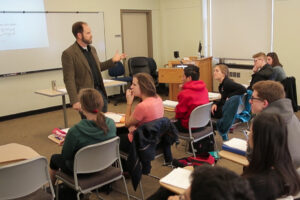 |
|
In the last TTT, I shared that I lecture. In this round of resources, we see a slight variation that I strive for called dynamic lecturing. The goal of dynamic lecturing is to get the learners more involved.
|
Teaching, Tech, and Tidbits Digest
The posts below are from a bi-weekly digest that encapsulates a range of evidence-based best practices and cutting-edge insights on innovative teaching strategies, effective use of technology, student engagement techniques, and effective assessment, to name a few. The content, diligently curated or crafted by the director Dr. Lew Ludwig, is grounded in robust research and drawn from a wide array of innovative articles, books, and online resources. The goal is to support timely, ongoing faculty development with the most current and impactful knowledge in the field.
Teaching – Delayed vs. Immediate Feedback, which is better?
 |
|
I always prided myself on returning feedback to students right away – usually by our next meeting. This required some forethought from me – collect on Friday to return on a Monday – but I thought it was pedagogically significant to get things back into their hands ASAP. Some recent studies show this might not be the case: Delayed and Immediate Feedback in the Classroom: The Results Aren’t What Students Think! |
Teaching – Keeping students engaged
 |
|
At this time last year, professors reported widespread anxiety, depression, and a lack of motivation in their classrooms. Hopefully, this year is faring better, but we can use our recent break to reset the tone in our classes if things have drifted. This Chronicle article, How to Solve the Student-Disengagement Crisis, provides tips from six experts on how to keep students engaged. |
Tidbit – lecture

Let me be honest – I lecture. While I intersperse active learning activities throughout, a large portion of my course content is presented through lectures. But how do I know if my students understand? Are they picking up what I am putting down?
- You can start with this infographic to consider the basics of effective lectures, including clear examples, sequencing, activating prior knowledge, and chunking.
Tech – Create a “testlet” in Canvas

If you want to try incorporating testlets into your own courses, you can do that right in Canavs by using the quizzes feature. Check out this Canvas Basics Guide on Quizzes to learn more about them. There’s also this video on how to get started with quizzes in Canvas.
Teaching – 10 ways to prevent cheating

As Process Advisor for Academic Integrity, I often see the aftermath of an integrity violation. But what if we, as faculty members, could craft our courses and assignments to reduce students’ temptation to cheat? In his short article “10 Ways to Prevent Cheating: Ten simple strategies to reduce academic dishonesty that don’t rely on students’ ethics,” Steven Mintz argues, “In the end, cheating is as much an engineering problem as a moral problem.
Teaching – So over COVID

In her piece, So Over COVID!, Prof. Lisa Lawmaster Hess shares her frustration with student attendance and participation. But she explains how an in-clas discussion with her first-year students revealed much she hadn’t consider. She writes, “During their sophomore year (of high school), everything had shut down. During their junior year, classes were hybrid. And senior year?
Tidbit – muddiest point

Many of us use the formative classroom assessment known as the muddiest point, allowing learners to share the material or idea they least understood. Unfamiliar with the practice or want to take it to the next level?
- You can start with this infographic to learn the basics.
- Are you already using the muddiest point? Take it to the next level with this infographic.
Tech – Canvas Grading Tips

This week’s Canvas related tip focuses on grading. After scouring the internet for helpful tips from those who have used Canvas a lot longer than those of us at Denison, ETS found a great video to share. Watch the video Top 5 Canvas Grading Tips for more on using rubrics, setting default grades, and more!
Do you have a Canvas tip you would like to share with colleagues?
Teaching – Ideas for that first test

We are well into the testing season. Whether you’ve given that first test or are preparing to, here are some quick ideas I got from a webinar from Dr. Diana Skrzydlo (University of Waterloo) on assessment.
Before the test:
When reviewing test topics in class, have students practice metacognition by actively rating their understanding of each topic.
